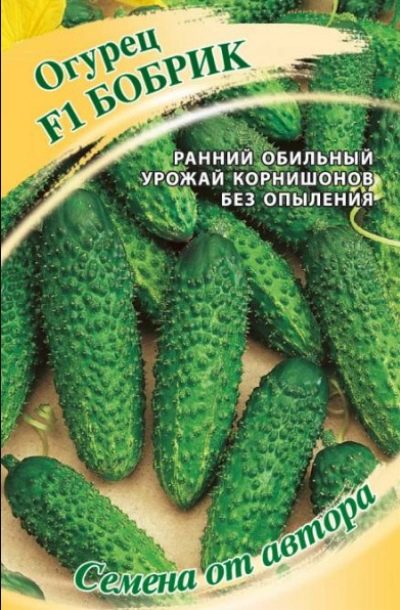
- Authors: Gavrish S.F., Portyankin A.E., Shamshina A.V., Prutenskaya N.A., Shevkunov V.N.
- Year of approval: 2006
- Growth type: indeterminate
- Branching: the average
- Fruit weight, g: 90-100
- Fruit length, cm: 10-12
- Fruit color: green with short stripes
- Ripening terms: early
- Fruit shape: cylindrical
- Fruit taste: excellent, no bitterness
The Bobrik cucumber is one of the few varieties that meet most of the requirements of vegetable growers, since when choosing a particular plant, gardeners pay special attention to the level of yield, difficulty in care and resistance to diseases.
Description of the variety
The culture is a hybrid variety created on the basis of the domestic agricultural firm "Gavrish". The plant is intended for growing in open and closed ground.
The beaver stands out favorably among its congeners. The pluses include:
high yield;
cold resistance, ovaries are able to form in cool weather;
excellent taste;
early ripening;
attractive appearance;
self-pollination;
tolerates a sharp temperature drop;
universal purpose in cooking;
persistent immunity to most infections.
The disadvantages include the inability to use the fruit to obtain seed. The plant is an F1 hybrid and therefore does not inherit the parental genes.
Characteristics of the appearance of plants and zelents
Indeterminate liana, reaching a height of 3.5 m. The branching is medium, the bushes are not dense, due to which the plant is well illuminated, allowing air to circulate freely between the shoots. The leaves are medium in size, saturated green. The leaf blade is wrinkled. Parthenocarpic species, predominantly female flowering type. 5-8 fruits are formed on one node. The root system is well developed.
Cucumbers are short, 10-12 cm long and weighing 90-100 g. Fruits are cylindrical, green in color with short stripes. The thin peel has a medium number of tubercles with white thorns. The hybrid is characterized by slow fruit growth. Zelentsy tolerate transportation well, keeping their presentation.
Purpose and taste of fruits
The crispy, dense and juicy pulp has an excellent sweet taste, without bitterness. The purpose in cooking is wide. Fresh cucumbers are added to salads, cold soups and snacks are made from them. In pickling and canning, the fruits retain a pleasant crunch, without forming voids in the pulp.
Maturation
A hybrid is valuable among gardeners for its early maturity. Full technical ripeness of fruits occurs 37-40 days after germination. You can enjoy the first greens at the end of June. Long-term fruiting.
Yield
Bobrik is distinguished by high yield rates. From 1 sq. m on average, you can get from 9.7 to 10.3 kg of fruit. With good climatic conditions and proper agricultural technology, the yield can be increased to 15 kg.
Growing regions
Designed for cultivation almost throughout the country. The plant shows high productivity in the Central, Volgo-Vyatka, Central Black Earth, North Caucasian and Middle Volga regions.
Landing scheme
Due to the fact that the hybrid is tall, when planting, it is necessary to observe the 50x50 cm scheme. This will enable the bushes to develop well and not thicken each other.
Growing and care
When choosing a place, you need to take into account that a cucumber is a thermophilic culture, therefore, it should be planted in the sunniest place, protected from drafts. Bobrik is able to put up with a little partial shade. Before planting a plant, the site must be prepared in the fall. The place is carefully dug up, organic matter and complex fertilizers are applied. A month before planting, the soil is once again dug up and enriched with rotted manure.
In the southern regions, the method of sowing seeds directly into the open ground is mainly used (in mid-May), in the northern regions, the greenhouse method is appropriate (at the end of April). The timing of planting seedlings in open soil or under a film is the end of May, the beginning of June.
To obtain strong and healthy seedlings, separate peat cups are used. The seedlings obtained in this way root better in a new place and more easily endure the adaptation period. Seeds germinate at a temperature of + 25 ... 26 degrees, with the emergence of shoots it is reduced to +20. The light regime should be at least 16 hours.
With the appearance of 4-5 full-fledged leaves, when the growth of seedlings reaches 20-25 cm, they are ready for planting in a permanent place. When planting, a handful of wood ash is added to each hole and poured abundantly with warm, settled water.
Caring for Bobrik is the simplest, which consists in carrying out regular irrigation (1 time in 3 days) with warm water in the evening, as well as spraying the bushes during periods of sultry heat. Top dressing must be applied systematically. They are fed with nitrogen when the plant begins to form ovaries. The second feeding is organized after 21 days - with compost. The third is carried out during the period of active formation and ripening of zelents - with nutritious components.

In order to collect strong, tasty and beautiful cucumbers on your site, you need to make top dressing. Lack of nutrients can negatively affect the appearance of the plant and significantly reduce the yield. Fertilize cucumbers with organic fertilizers in combination with mineral fertilizers. With the right balance of these components and adherence to the fertilizing schedule, the cucumber yield will be maximum.
Disease and pest resistance
Breeders managed to create a hybrid that is practically not affected by infections. However, if you neglect the rules of care, then the plant can be exposed to fungal and bacterial diseases.

Despite their popularity, cucumbers are often attacked by diseases and pests. From them, cucumber plantings often die before the start of fruiting. In order to prevent this from happening, it is necessary to try to prevent ailments or get rid of them at the very beginning, having studied in detail their causes of occurrence, signs and methods of treatment.





























































































